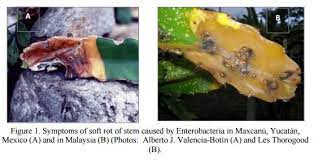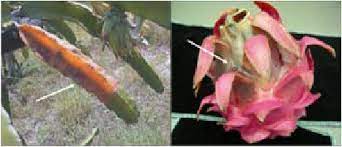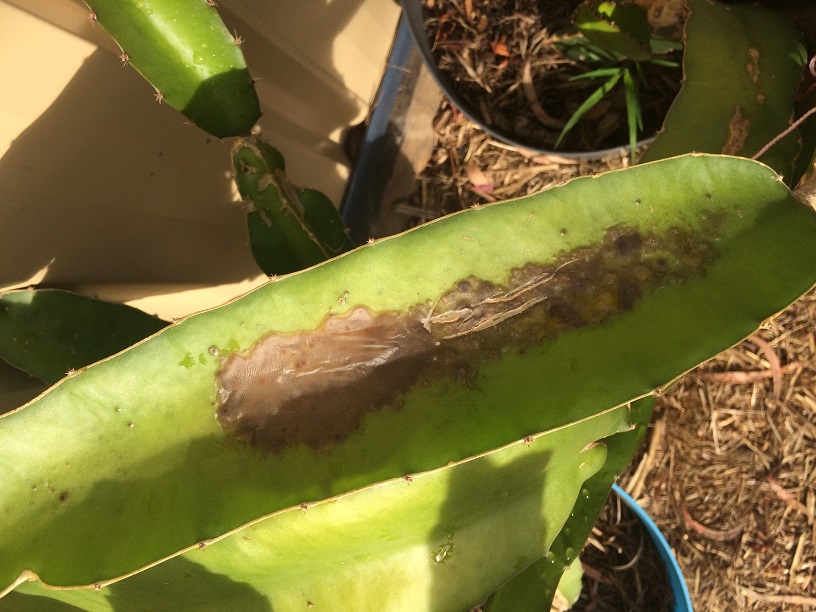In the realm of dragon fruit cultivation, the specter of bacterial soft rot casts a shadow over the orchard’s vitality. This destructive disease, which the sneaky pathogen Erwinia is to blame for, presents a significant threat to the wellbeing and productivity of dragon fruit plants. In this talk, we will get into the details of bacterial soft rot, including what causes it, what its symptoms are, and how to treat it so that dragon fruit stays safe from Erwinia.
Table of Contents
Understanding Bacterial Soft Rot
The genus Erwinia orchestrates bacterial soft rot, which emerges as a key adversary in the delicate ecosystem of dragon fruit cultivation. This opportunistic pathogen thrives in environments conducive to moisture and warmth, exploiting wounds and tissue vulnerabilities to infiltrate the plant’s defenses. Upon colonization, Erwinia instigates enzymatic degradation of plant tissues, culminating in rapid tissue maceration and collapse.

Causes of Dragon Fruit Rot
Dragon fruit can rot due to various factors, including:
- Fungal Pathogens: Besides bacterial diseases, fungal pathogens like Colletotrichum can lead to rot in dragon fruit.
- Environmental Factors: Excessive moisture, high humidity, and poor air circulation create favorable conditions for rot.
- Physical Damage: Wounds, bruises, or injuries during handling or transport provide entry points for pathogens.
- Improper Storage: Inadequate storage conditions, especially in high-temperature and high-humidity environments, can accelerate rot.
Key Characteristics:
- Moisture Dependence: Flourishes in humid conditions, perpetuated by irrigation practices and environmental factors.
- Necrotic Lesions: Characterized by soft, water-soaked lesions spreading from the injection site.
- Foul Odor: Emitting a characteristic foul odor, reminiscent of decay and decomposition.
- Rapid Progression: Exhibits exponential proliferation, leading to swift deterioration of infected tissues.

Symptoms and Manifestations
The onset of bacterial soft rot heralds a cascade of symptoms indicative of the plant’s distress in the clutches of Erwinia. Initially, discrete water-soaked lesions manifest at wound sites or points of tissue injury, serving as gateways for bacterial infiltration. As the infection progresses, lesions coalesce, engendering widespread tissue maceration and collapse. The afflicted tissues assume a characteristic slimy texture, exuding a putrid odor synonymous with bacterial degradation.
Notable Symptoms:
- Lesion Formation: Water-soaked lesions at wound sites, expanding rapidly.
- Tissue Maceration: Progressive softening and breakdown of infected tissues.
- Foul Odor: Emanating from infected tissues, signaling advanced decay.
- Discoloration: Manifests as darkened regions surrounding the lesion periphery.
Management Strategies
The pursuit of effective management strategies constitutes the cornerstone of bacterial soft rot control in dragon fruit orchards. Orchestrating a multifaceted approach, orchardists endeavor to mitigate disease incidence and curtail pathogen dissemination through proactive interventions.

Cultural Practices:
- Sanitation Protocols: Enforce rigorous sanitation measures to minimize pathogen reservoirs and mitigate disease spread.
- Pruning and Removal: Prompt removal of infected plant tissues and adoption of stringent pruning practices to deter disease propagation.
- Quarantine Measures: Implement quarantine protocols for new plant introductions to prevent the introduction of Erwinia into established orchards.
Environmental Manipulation:
- Optimized Irrigation: Adopt judicious irrigation practices to minimize excessive moisture accumulation, thereby attenuating favorable conditions for bacterial proliferation.
- Aeration Enhancement: Foster optimal air circulation within the orchard to mitigate humidity and reduce the risk of bacterial soft rot development.
Biological Controls:
- Antagonistic Microorganisms: Harness the biocontrol potential of beneficial microorganisms to suppress Erwinia proliferation and fortify plant defenses against bacterial incursions.
Chemical Interventions:
- Copper-Based Fungicides: Deploy copper-based formulations judiciously to mitigate bacterial soft rot incidence and curtail pathogen dissemination.
- Antibacterial Compounds: Explore the efficacy of antibacterial compounds in combating Erwinia infection, adhering to recommended application rates and intervals.
Conclusion
In the intricate tapestry of dragon fruit cultivation, the menace of bacterial soft rot poses a formidable threat to orchard sustainability and productivity. By unravelling the enigmatic nature of Erwinia-mediated decay and embracing proactive management strategies, orchardists embark on a journey of resilience and vitality. Through vigilance, innovation, and collective stewardship, the orchard thrives amidst the dynamic interplay of nature’s forces and is resilient in the face of bacterial adversity.
you can read about more dragon fruit diseases by clicking here.
FAQ’s
What bacterial diseases do dragon fruit get?
Several bacterial diseases can affect dragon fruit, with soft rot from Erwinia being one of the most common. Additionally, dragon fruit may also suffer from bacterial spot, bacterial black spot, and bacterial wilt, among other bacterial infections.
What is Erwinia amylovora soft rot?
The bacterium Erwinia amylovora is the source of the bacterial soft rot known as “Erwinia amylovora soft rot.” This pathogen primarily affects pome fruit trees, such as apples and pears, causing a rapid breakdown of plant tissues and often resulting in severe damage to orchards.
How do you treat Erwinia bacteria?
Managing Erwinia bacteria involves employing a combination of cultural, biological, and chemical control methods. Cultural practices, including sanitation measures, proper pruning techniques, and irrigation management, help reduce the risk of bacterial infection. Biological control agents, such as antagonistic microorganisms, may be employed to suppress Erwinia proliferation. Additionally, the judicious use of bactericides, such as copper-based fungicides, can help mitigate Erwinia populations and prevent the spread of bacterial diseases.
What causes dragon fruit to rot?
Dragon fruit can rot due to various factors, including fungal pathogens like Colletotrichum, bacterial infections like Erwinia, improper storage conditions leading to moisture buildup, physical injuries or wounds during handling, and environmental stressors such as high humidity or temperature fluctuations. Inadequate sanitation practices and poor orchard management can also contribute to the onset of rot in dragon fruit. Regular inspection, prompt removal of diseased fruits, and implementation of effective disease management strategies are essential for preventing rot and maintaining fruit quality in dragon fruit.
